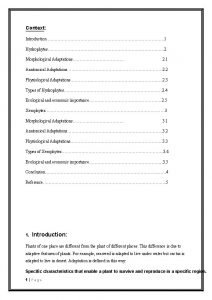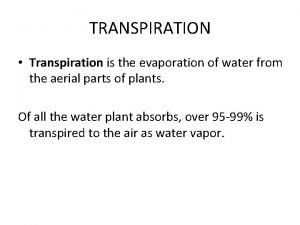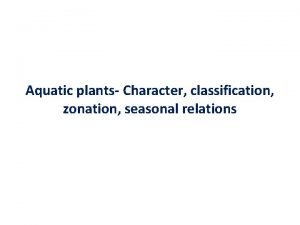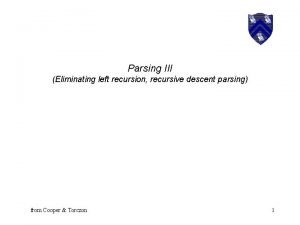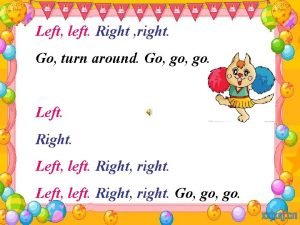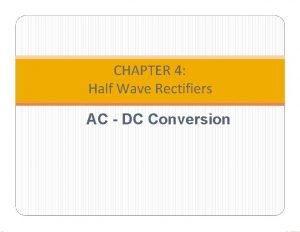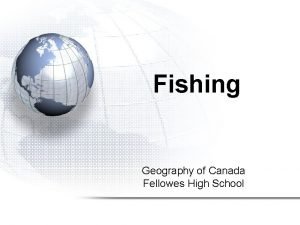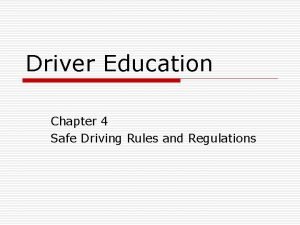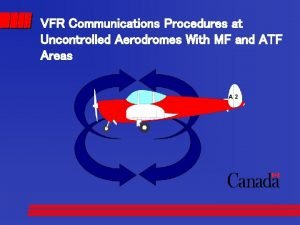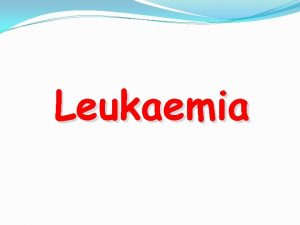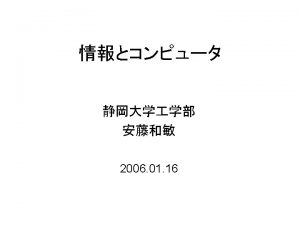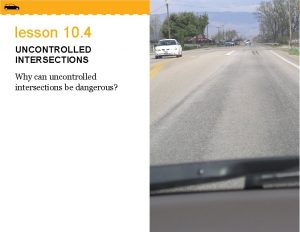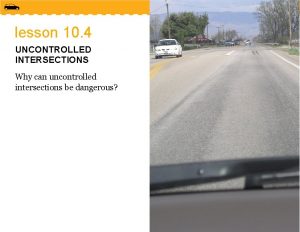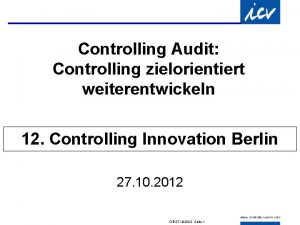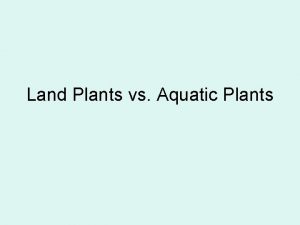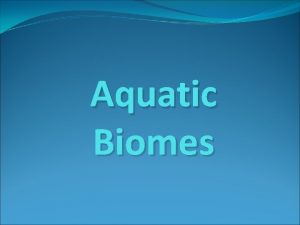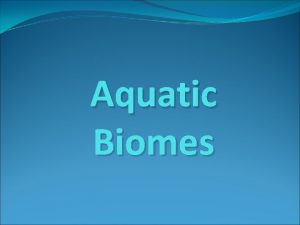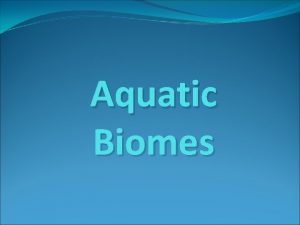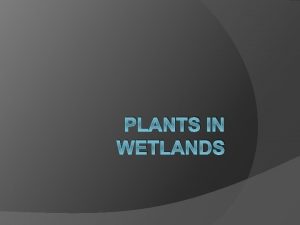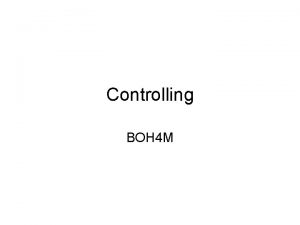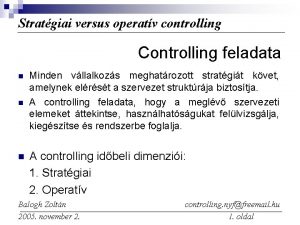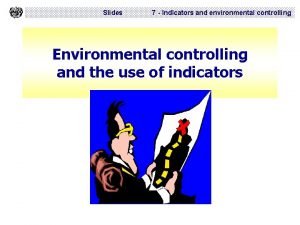Controlling Aquatic Plants When left uncontrolled aquatic plants
























- Slides: 24

Controlling Aquatic Plants

When left uncontrolled, aquatic plants • Impair recreational uses • Cause foul odors and bad taste to drinking water • Cause fish kills • Stunt fish growth • Reduce water depth as plants die • Increase nuisance insect populations • Decrease property values • Cause accidental drowning • Block water flow in irrigation and drainage ditches

A problem when vegetation covers more than 20 -25% of shallow area more than 50% of a body of water

Two groups of aquatic plants Algae Flowering Plants

Algae • Microscopic algae (phytoplankton) • Filamentous algae (moss) • Chara (stonewart)

Flowering plant categories • Emergent plants • Rooted floating plants (emergent) • Free floating plants • Submersed plants

Emergent plants • rooted in sediment • most of foliage above water • cattails, bulrushes, willows • most “wetland” plants are emergent ©USDA, NRCS @ PLANTS

© USDA, NRCS @ PLANTS

© USDA NRCS, 1995 Midwestern Wetland Flora @ PLANTS

Rooted floating plants • lilies, spatterdock • rooted in sediment • leaves and flowers float on water surface © USDA, NRCS

Free floating plants • duckweed, water meal • not rooted in sediment • freely float in water © USDA, NRCS, 1997 Northeastern Wetlands Flora @ PLANTS

Submersed plants • elodea, pondweeds • rooted in sediment • only flowering structure emerges above water surface © NRCS @ PLANTS © USDA, NRCS, 1997 – Northeastern Wetlands Flora @ PLANTS

Pond Management– What’s your goal? • • • Recreational fishing Swimming & boating Wildlife habitat / aesthetics Livestock water supply Aquaculture Storm water management

Aquatic Plant Control – Physical • • • Benthic barriers Drawdown Mechanical removal Dredging Dyes

Aquatic Plant Control – Biological • Grass carp

Aquatic Plant Control – Chemical • Identify the problem plant • Use only EPA registered and approved products • Read and follow all label directions • Timing – late spring, early summer • Temperature – Over 65° • Retreat?

Calculating treatment area Herbicide applications made on two parameters– • Surface area basis for control of rooted floating and emergent plants • Volume basis for control of algae and submersed plants

Surface area • Rectangular area acres = length (ft) x width (ft) 43, 560 ft 2 • Circular area (radius measured in feet) acres = 3. 1416 x radius 2 43, 560 ft 2 • Triangular area acres = ½ base (ft) x height (ft) 43, 560 ft 43, 560 = number of square feet per acre

Depth • Measure – don’t assume • Measure at intervals, average together

Volume Acre-feet = surface area (acres) x average depth (ft) Example: Area = 240 ft x 120 ft 43, 560 ft = 0. 66 acre Average depth = 2+4+9/3 = 5 ft Volume = 0. 66 acre x 5 ft = 3. 3 acre-ft

Amount required Pounds required = 2. 7 lb x ppm desired x acre-ft (from label) Example: Required dose is 2 ppm. Amount = 2. 7 lb x 2 ppm x 3. 3 acre-ft = 16. 2 lb of product

Permits Private applicator permit Purchase and apply restricted-use pesticides to privately owned lake or pond, or drainage ditch. Commercial application of pesticides (for hire) requires a commercial license, Category 5. For information on pesticide permits contact Office of Indiana State Chemist 765/494 -1492

IDNR permit A permit from IDNR is required when • a lake resident treats more than 625 sq. ft; more than 25 linear ft along shore and in water deeper than 6 ft. • a biological organism (grass carp) is used to control plants. • mechanical control is used in areas larger than 625 sq. ft.

IDNR permit • Obtained from Division of Fish & Wildlife • $5 filing fee • IDNR Fish & Wildlife 402 W. Washington St. , Rm. W 273 Indianapolis, IN 46204 317/232 -4093
 Hydrilla morphological adaptation
Hydrilla morphological adaptation Stomatal transpiration diagram
Stomatal transpiration diagram Aquatic plants classification
Aquatic plants classification Left left right right go go go
Left left right right go go go Upstage vs downstage
Upstage vs downstage For top-down parsing left recursion removal is
For top-down parsing left recursion removal is Turn left at the corner
Turn left at the corner You put your left foot in
You put your left foot in Muscle energy technique si joint
Muscle energy technique si joint Go left left right right
Go left left right right Vdc in half wave rectifier
Vdc in half wave rectifier Uncontrolled foreign fishing
Uncontrolled foreign fishing Chapter 7 negotiating intersections
Chapter 7 negotiating intersections Uncontrollable outburst of fear
Uncontrollable outburst of fear Not genuine, not true, not valid
Not genuine, not true, not valid Controlled uncontrolled and blind intersections
Controlled uncontrolled and blind intersections An uncontrolled railroad crossing usually has a
An uncontrolled railroad crossing usually has a Stages of drawing development
Stages of drawing development Uncontrolled aerodrome procedures
Uncontrolled aerodrome procedures At an open or uncontrolled intersection, yield if _____.
At an open or uncontrolled intersection, yield if _____. Uncontrolled clonal proliferation
Uncontrolled clonal proliferation Controlled and uncontrolled observation example
Controlled and uncontrolled observation example Uncontrolled cell division
Uncontrolled cell division Uncontrolled copy 意味
Uncontrolled copy 意味 Classification of non flowering plants
Classification of non flowering plants
